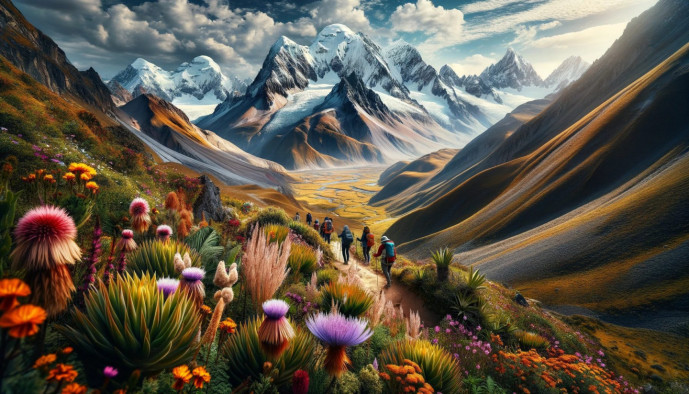Geography of Bolivia
Explore Bolivia's diverse terrain, from Andean peaks to Amazonian rainforests.

Physical Landscape
Andean Region
The Andean region is Bolivia’s spine, boasting the majestic Cordillera Occidental and Cordillera Central, where you’ll find snow-capped peaks like the formidable Sajama, towering over 6,500 meters. Let’s not forget the Altiplano, a high plateau that’s more than just a geography nerd’s dream—it’s where the Earth seems to touch the sky.
Sub-Andean Region
The Sub-Andean region is the less dramatic but still rugged sibling, with fertile valleys home to quaint villages. It’s where indigenous culture throbs strong, and the terraced hillsides will have you snapping pics until your camera begs for mercy.
Llanos (Plains)
The Llanos are Bolivia’s slice of the grasslands, stretching out like a green carpet rolled out for the gods. It’s cowboy country and vast, flat expanses where the horizon plays hide and seek.
Amazon Basin
Trek into the Amazon Basin, and you’ll swap altitude for attitude as you plunge into dense, lush rainforests. This is the green heart of Bolivia, throbbing with biodiversity and rivers that meander like they’ve had one too many chicha beers.
Climate Zones
Tropical Climate
The tropical climate reigns supreme in the lowlands, where sweating is a way of life and the sun plays its favorite game—turn up the heat. Pack light clothes and a sense of adventure.
Subtropical Climate
The subtropical climate zones flirt with both warmth and cool breezes. Found in the Sub-Andean region, they’re the middle child of climates, often overshadowed but always pleasantly temperate.
Temperate Climate
Temperate climate areas are Bolivia’s mood swings, with a climate that can’t decide if it’s hot or cold. Found in the valleys and mid-altitudes, they’re perfect for those who like wardrobe changes.
Altiplano Climate
Over in the Altiplano, the Altiplano climate commands respect with its icy nights and surprisingly warm days. It’s like Mother Nature can’t make up her mind, so she threw in everything.
Major Geographical Features
Mountains and Highlands
Bolivia’s mountains and highlands aren’t just pretty faces; they’re geological titans. The Andes are the stars, with peaks that make even the clouds look like underachievers.
Rivers and Lakes
The country’s rivers and lakes are the lifeblood of its ecosystems. From the mighty Beni and Madre de Dios rivers to the legendary Lake Titicaca, shared with Peru, these waters have stories to tell.
Salt Flats and Deserts
The salt flats and deserts are where Bolivia shows off its quirky side. Uyuni is the poster child, a salt flat so vast you can see the curve of the Earth, and so white you’ll think you’ve landed on another planet.
Biodiversity and Ecosystems
Flora
The flora in Bolivia ranges from Amazonian rainforest greenery to high-altitude Polylepis trees. It’s like nature’s own botanical garden, minus the entrance fee.
Fauna
For fauna, think pink—flamingos in the altiplano or capybaras chilling in the lowlands. And let’s not forget the jaguars, who are the real kings of the jungle, not those noisy howler monkeys.
National Parks and Reserves
National Parks and Reserves in Bolivia are the VIP lounges for Mother Nature’s finest. Madidi National Park alone packs in more biodiversity than some continents can muster.
Natural Resources
Minerals and Metals
Bolivia is a treasure chest of minerals and metals, with silver, gold, and tin. Potosí’s Cerro Rico isn’t called “Rich Hill” for nothing—though it’s also a sobering reminder of colonial exploitation.
Hydrocarbons
Hydrocarbons might not be party talk, but Bolivia’s got them in spades. Natural gas is the country’s hot-ticket item, powering not just stoves but also economies.
Agricultural Land
The agricultural land here feeds both people and imaginations. Think quinoa fields that sparkle gold in the sun, and the yungas where coffee and coca plants play hide and seek on the slopes.
Environmental Challenges
Deforestation
Deforestation is like a bad haircut for the Earth—too much gone, and suddenly, it’s not looking so good. The Amazon is at risk, and it’s not a great look for anyone.
Climate Change Impact
Climate Change Impact is the uninvited guest who’s overstaying their welcome, especially in the fragile Altiplano, where glaciers are retreating faster than shy vicuñas.
Water Resource Management
Bolivia’s water resource management is a puzzle with missing pieces, as recurring droughts and water shortages in cities like La Paz show that sometimes, the tap runs dry.
In Bolivia, geography isn’t just about maps and mountains; it’s a living, breathing drama with Mother Nature as the prima donna. Whether it’s the dizzying heights of the Andes or the steamy depths of the Amazon, this country is a geography lesson with a pulse. Pack your bags (and maybe an oxygen tank), because Bolivia’s geography is not just about scenic landscapes—it’s about adventure with a capital A.